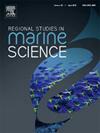菲律宾莱特湾市沿海地区微塑料丰度、特征及相关生态风险评估
IF 2.1
4区 环境科学与生态学
Q3 ECOLOGY
引用次数: 0
摘要
本研究旨在首次描述菲律宾莱特湾市选定沿海地区水体和沉积物中微塑料的分布、特征和生态风险。选取了10个沿海村庄,并基于空间变异对其进行了选择。研究发现,水中的微塑料污染水平为50.0 ~ 216.67 ± 28.9 Items/L,沉积物中的微塑料污染水平为233.3 ± 57.7-516.67 ± 28.9 Items/Kg。最常见的MP形状类型是纤维、薄膜、碎片和薄片。本研究中主要的聚合物类型是PS(聚苯乙烯),PETE(聚对苯二甲酸乙二醇酯)和聚丙烯(PP)。黑色、蓝色、白色和透明是这项研究中发现的主要颜色。水样中微塑料粒径以大(>1.5 mm)和中(>1.5 mm)为主,沉积物中微塑料粒径以小(<0.5 mm)为主。本研究测量了四项污染参数。污染因子值表明样品受到严重污染。污染负荷指数表明所有样本均为污染(>1)。聚合物风险值提示风险类别为III级,最后所有样本的污染风险评估值提示高风险类别。所有这些参数都通过地理信息系统(GIS)的空间分布图显示出来。这项研究的结果表明,在海水和沉积物中发现的微塑料在MP污染的背景下是至关重要的,强调了进一步研究的必要性。本文章由计算机程序翻译,如有差异,请以英文原文为准。
Microplastic abundance, characteristics, and associated ecological risk assessment in the selected coastal areas of Baybay City, Leyte, Philippines
This study aimed to provide the first description of the distribution, characteristics, and ecological risk of microplastics in water and sediment of selected coastal areas of Baybay City, Leyte, Philippines. A total of 10 coastal villages were sampled, and they were selected based on spatial variation. This study found microplastic contamination levels ranging from 50.0 to 216.67 ± 28.9 Items/L in water and 233.3 ± 57.7–516.67 ± 28.9 Items/Kg in sediment. The most common types of MP shapes were Fiber, Film, Fragment, and Flakes. The dominant polymer types in this study were PS (polystyrene), PETE (polyethylene terephthalate), and polypropylene (PP). Black, blue, white, and transparent were the dominant colors found in this study. The major microplastic size found in water samples were Large (>1.5 mm) and Medium (0.5–1.5 mm), and the dominant size in the sediment sample was small (<0.5 mm). Four pollution parameters were measured in this study. The contamination factor value indicated that the samples were highly and considerably contaminated. The Pollution Load Index indicated all samples as polluted (>1). The polymeric risk value indicated risk category level III, and finally Pollution risk assessment value for all samples indicated a high-risk category. All of these parameters were shown through a spatial distribution map using Geography and Information System (GIS). The findings of this study suggest that microplastics found in marine water and sediment are crucial in the context of MP pollution, highlighting the need for further research.
求助全文
通过发布文献求助,成功后即可免费获取论文全文。
去求助
来源期刊

Regional Studies in Marine Science
Agricultural and Biological Sciences-Ecology, Evolution, Behavior and Systematics
CiteScore
3.90
自引率
4.80%
发文量
336
审稿时长
69 days
期刊介绍:
REGIONAL STUDIES IN MARINE SCIENCE will publish scientifically sound papers on regional aspects of maritime and marine resources in estuaries, coastal zones, continental shelf, the seas and oceans.
 求助内容:
求助内容: 应助结果提醒方式:
应助结果提醒方式:


